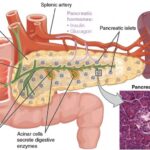Glucagon In Metabolic Process|Chemical Structure Of Fats
RIPPEDFAT

Balancing Blood Sugar Naturally
Differences Between Saturated and Unsaturated Fats
Glucagon in metabolic process, glucagon has effects opposite to insulin, and together, they form a system that maintains stable blood glucose levels. Glucagon is secreted by the alpha cells in the pancreas when blood sugar levels fall, during prolonged fasting, exercise, or after protein-rich meals. High blood sugar levels can result from a lifelong habit of consuming high-sugar carbohydrates, if these calories are not immediately used for energy, they become stored as fat in the form of triglycerides, leading to the release of free fatty acids in the pancreas imbalancing the chemical structure of fats in the bodycausing:
- Metabolic problems
- Poor dietary habits
- Weak immune system
- Enlarged pancreas
- Brain fog
- Weight gain
Insulin is a hormone that regulates blood sugar levels when you eat carbohydrates your body breaks them down into glucose. When blood glucose are high, the body releases insulin to decrease sugar levels by promoting its uptake in insulin-dependent tissues to help cells absorb glucose for energy storage. Conversely, the pancreas also produces glucagon, a hormone that increases blood glucose levels when they are too low, by prompting the liver to convert stored glycogen into glucose. Carbohydrate intake and high blood glucose levels inhibit glucagon release, as the body prioritizes lowering glucose levels. Insulin and glucagon are regulatory partners; if high glucose levels suppress glucagon, the liver won’t convert glycogen into glucose, preventing further blood glucose elevation.
body releases insulin to decrease sugar levels by promoting its uptake in insulin-dependent tissues to help cells absorb glucose for energy storage. Conversely, the pancreas also produces glucagon, a hormone that increases blood glucose levels when they are too low, by prompting the liver to convert stored glycogen into glucose. Carbohydrate intake and high blood glucose levels inhibit glucagon release, as the body prioritizes lowering glucose levels. Insulin and glucagon are regulatory partners; if high glucose levels suppress glucagon, the liver won’t convert glycogen into glucose, preventing further blood glucose elevation.
dietary Fat From Food
Saturated Fats
Unsaturated Fats
There are four major types of dietary fats found in the foods we consume.
- Saturated fats primarily come from animal sources such as meat, poultry, pork, and dairy products like cheese, butter, and milk. They are also present in processed meats like sausages, bacon, cooked meats, and pre-packaged snacks including crackers, pastries, and cookies, as well as in plant-based foods containing coconut oil and palm oil. Although not all processed foods are unhealthy, some have high levels of salt, sugar, and fat.
- Saturated fats typically remain solid at room temperature, whereas unsaturated fats, which are mostly derived from plants, are liquid. Excessive consumption of saturated fats, especially those found in processed foods, can adversely affect your health by raising bad LDL cholesterol levels in your blood, thereby increasing the risk of heart disease, stroke, and diabetes.
- Trans fats are artificially created fats and are used in many processed foods to improve taste and extend shelf life. They are considered most harmful of the fats.
-
- Unsaturated fats, which are liquid at room temperature, are deemed heart-healthy because they can help lower bad LDL cholesterol levels. These fats mostly derive from plant sources like olive oil, avocados, and nuts, and are less likely to contribute to artery blockage.
- Monounsaturated fats, a category of unsaturated fats, are beneficial for cell health. Foods rich in monounsaturated fats include olive oil, sesame oil, and canola oil.
- Polyunsaturated fats, which the body cannot produce and must be obtained from food sources like fish or nuts and flaxseeds, encompass oils such as safflower, sunflower, and corn oil. Essential for the body, polyunsaturated fats are categorized into omega-3 and omega-6 fatty acids, both vital for brain function and cell growth.
Glucagon In Metabolic Process
Relationship Between Insulin glycaemic Foods And Weight Loss
Glucagon and insulin are integral to the metabolic process, and the chemical structure of fats establishes a set point, which is the preferred state of metabolism where the body is balanced and not subject to fluctuations or starvation that can disrupt this set point. For weight loss, the pancreas releases the hormone glucagon, which is distinct from glucose and acts in opposition to insulin. Within the pancreas, 60% of the cells are beta cells, which produce insulin, the hormone responsible for sugar creation and fat storage as glycogen.
Conversely, glucagon in metabolic process is the primary hormone for fat burning and weight loss. It serves as an effective ketones blood glucose meter, releasing stored fat from glycogen to be used as energy and burned off, but this only occurs when insulin levels are low. Diets within the glycaemic index food list is associated with insulin sensitivity to lower blood sugar levels so that the body becomes more efficient using insulin to lower blood sugar levels. Only carbohydrate foods are listed on the glycaemic index food table, which is used to determine sugar content or fiber content for a diet that promotes a higher metabolism and slow-burning energy boost.
Balancing Blood Sugar Naturally
The Chemical Association Of Fats
The chemical structure of fats is significant in the context of energy usage by the body. Glycogen, which is easier for the body to utilize as energy, becomes the focus when blood sugar levels rise excessively after consuming carbohydrate-rich foods. This surge in blood sugar can lead to an imbalance, causing glucose to rapidly enter the bloodstream.
When fat cells, which store glycogen, reach their capacity, it triggers a reaction that increases insulin production.
Insulin, a hormone associated with fat creation, then facilitates the metabolism of this excess sugar, converting it into fat that circulates in the bloodstream, ready to be used as energy. However, when attempting to lose weight, if the body’s stored energy, in the form of glucose within fat cells, is too high, the body primarily burns sugar instead of fat. Elevated blood sugar levels can cause the pancreas to release more insulin, which can impede weight loss efforts and negatively impact overall health.
Success Is Depleting Glucose Stored Glycogen
Excessive sugar (glucose) in the bloodstream can lead to feelings of tiredness, hunger, and food cravings, affecting your metabolism and your body’s chemical structure of fats. To break this relentless cycle, it’s necessary to bring your body and metabolism to a set point where it functions optimally. Insulin is the hormone that regulates blood sugar by processing carbohydrates into glucose. To reach a set point quickly, one must focus on glucose metabolism, to first deplete stored glycogen, ceasing to use glucose as your primary energy source for at least fourteen days, allowing the body to regulate glucose levels effectively.
Many people, without realizing it, have created a situation where their body’s delicate balance of blood sugar is overwhelmed by an excessive intake of sugar and rapidly digestible carbohydrates. This leads to fluctuating blood sugar levels, carbohydrate cravings, and potentially sets the stage for sugar addiction and ongoing weight issues.
Successfully depleting the stored glucose, which is held as glycogen, and returning to healthier eating habits can pave the way to a proper fat-burning and weight loss diet.
Body Burns Off Fat Not Only Sugar
With ketones
Glucagon in metabolic process plays a role in the metabolic process by tapping into fat cells’ energy reserves and reducing stored insulin, which are key factors in burning fat when losing weight or building muscle. Fat burning is distinct from fat loss, as it does not equate calorie carbohydrates with fiber, since fiber is indigestible. Consuming fiber-rich carbohydrates can have a thermogenic effect, impacting insulin not due to delayed release but because the total calories and carbohydrates drive insulin levels, not the other way around.
Muscle and fat function differently within the body; muscle is more metabolically active and requires more calories to maintain than an equivalent amount of fat.
Recognizing that your body is utilizing fat rather than just sugar indicates a response to glucagon in the metabolic process, leading to fat loss. Difficulty in losing weight often stems from only burning off sugar stored as glycogen, which is used before fats.
To achieve a higher metabolism-boosting diet, it is advisable to avoid foods high in fast-absorbing carbohydrates. A diet that boosts metabolism ensures the body burns fats as the primary energy source, not just sugar, with low glycemic index (GI) foods being optimal.
⇐⇓⇑⇔
⇔ Glucagon Vs Glycogen

Fiber Protein Fats Carbs ⇔
⇔ Chemical Structure Of Fats
Make Insulin Sugar Zero ⇔
Fiber fat Fighting Destroyer: From a ripped
weight loss point of view insulin is the primary regulator for piling on the pounds it is a combination of stored sugar starches and fats but also has other functions but not for weight loss or muscle definition
It retains sodium
It drives protein or amino acids into the cells blocks any chance to you losing the flab
It effects fats and protein metabolism
Converts sugar into cholesterol
Converts sugar into triglycerides (blood fats)
Increases tension in the arteries – increasing blood pressure
Insulin, a hormone produced by the pancreas, regulates blood sugar levels that rise after consuming foods high in fast-release carbohydrates. These spikes can lead to blood sugar imbalances; for instance, consuming carbohydrate-rich foods increases glucose levels. The body’s bloodstream naturally contains about two tablespoons of glucose, and it is not equipped to store more than this amount without causing toxicity. Managing blood sugar and insulin levels is a delicate balance, involving the intake of fast-release sugars and starches to maintain stability.
The Glycaemic Index (GI) of foods is a useful tool for determining their impact on blood sugar levels, which is particularly relevant for weight management.
The chemical structure of fats is influenced by diet and the quantity consumed, which can elevate insulin levels; excess is stored as fat. Insulin, a regulator of blood sugar and starch storage, can lead to fatty liver when present in high amounts. Excessive insulin can also cause muscle wasting, converting protein into sugar and leaving behind a carbon skeleton, as all excess nutrients eventually convert to sugar. This can progress to diabetes, with serious complications such as clogged arteries, kidney failure, and disorders related to protein destruction.
Glucagon in metabolic process plays a role in the metabolic process by tapping into fat cells’ energy reserves and reducing stored insulin, which are key factors in burning fat when losing weight or building muscle. Fat burning is distinct from fat loss, as it does not equate calorie carbohydrates with fiber, since fiber is indigestible. Consuming fiber-rich carbohydrates can have a thermogenic effect, impacting insulin not due to delayed release but because the total calories and carbohydrates drive insulin levels, not the other way around.
Muscle and fat function differently within the body; muscle is more metabolically active and requires more calories to maintain than an equivalent amount of fat.
Recognizing that your body is utilizing fat rather than just sugar indicates a response to glucagon in the metabolic process, leading to fat loss. Difficulty in losing weight often stems from only burning off sugar stored as glycogen, which is used before fats.
To achieve a higher metabolism-boosting diet, it is advisable to avoid foods high in fast-absorbing carbohydrates. A diet that boosts metabolism ensures the body burns fats as the primary energy source, not just sugar, with low glycemic index (GI) foods being optimal.
